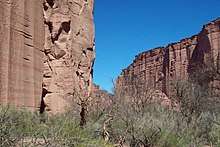Talampaya Formation
The Talampaya Formation is an Early Triassic (Olenekian) geologic formation in the Ischigualasto-Villa Unión Basin of La Rioja Province in northwestern Argentina. The pink to red sandstones of the formation represent the oldest sedimentary unit in the basin, overlying basement rock and were deposited in a high-energy braided river environment. Ichnofossils, probably left by an archosaur chirotherian, were found in the formation. The formation crops out in the Talampaya National Park, which was designated a UNESCO World Heritage Site in 2000.
| Talampaya Formation Stratigraphic range: Olenekian ~251.3–247.2 Ma | |
|---|---|
 Sandstones in Talampaya National Park | |
| Type | Geological formation |
| Unit of | Paganzo Group |
| Underlies | Tarjados Formation |
| Overlies | Basement |
| Thickness | Up to 400 m (1,300 ft) |
| Lithology | |
| Primary | Sandstone |
| Other | Conglomerate, tuff |
| Location | |
| Coordinates | 29.6°S 68.1°W |
| Approximate paleocoordinates | 46.0°S 40.2°W |
| Region | La Rioja Province |
| Country | |
| Extent | Ischigualasto-Villa Unión Basin |
| Type section | |
| Named for | Talampaya River |
| Named by | Romer & Jensen |
| Year defined | 1966 |
 Talampaya Formation (Argentina) | |
Description
The formation was first defined by Romer and Jensen in 1966,[1] based on a type section exposed in the Talampaya River canyon.[2] The Talampaya Formation belongs to the Paganzo Group.[3]
The formation represents the oldest sedimentary unit in the Ischigualasto-Villa Unión Basin in the Talampaya National Park of La Rioja Province, overlying Paleozoic basement, formed by the Tuminico Formation.[4] The Talampaya Formation is overlain by the arid fluvial sandstones and conglomerates of the Tarjados Formation, eroding the Talampaya Formation.[5]
The formation, reaching a maximum thickness of 400 metres (1,300 ft) with a general thickness of approximately 260 metres (850 ft),[6][7] comprises pink to reddish sandstones,[8] deposited in a fluvial environment, dominated by high-energy braided rivers producing sheet floods.[9][10] The sediments were deposited under uniform climatic conditions with temperate to warm temperatures and high humidity.[11] Other facies recognized in the formation are alluvial fan deposits with thin tuffaceous beds and conglomerates, covered by a section of basaltis and other volcanic agglomerates and eolian sandstones.[12]
Tetrapod ichnofossils, probably belonging to a chirotherian (and possibly an archosaur),[11] were discovered in the formation southeast of Pagancillo by Argentina paleontologist José Bonaparte in 1964.[3]
See also
- Sanga do Cabral Formation, contemporaneous fossiliferous formation of the Paraná Basin in southeastern Brazil
- Katberg Formation, contemporaneous fossiliferous formation of the Karoo Basin in South Africa
- Fremouw Formation, contemporaneous fossiliferous formation of Antarctica
References
- Caselli, 1998, p.22
- Caselli, 1998, p.23
- Leonardi, 1994, p.19
- Aceituno Cieri et al., 2015, p.59
- Balabusic et al., 2001, p.26
- Aceituno Cieri et al., 2015, p.60
- Monetta et al., 2000, p.648
- Talampaya Formation
- Caselli, 1998, p.147
- Balabusic et al., 2001, p.25
- Balabusic et al., 2001, p.28
- Caselli, 1998, p.24
Bibliography
- Aceituno Cieri, P.; M.E. Zeballos; R.J. Rocca; R.D. Martino, and C. Carignano. 2015. Condicionantes geológicos en el cruce de la sierra de Valle Fértil. San Juan - Geological constraints at the crossing of sierra Valle Fertil. San Juan. Revista de Geología Aplicada a la Ingeniería y al Ambiente 35. 57–69.
- Balabusic, Ana M., et al. 2001. Plan de Manejo del Parque Nacional Talampaya, 1–68. Administración de Parques Nacionales. Accessed 2019-03-28.
- Caselli, Alberto Tomás. 1998. Estratigrafía y sedimentología de las formaciones Patquía (Pérmico) y Talampaya (Triásico Inferior), en las Sierras Pampeanas Noroccidentales y Precordillera Central (Provincias de La Rioja y San Juan) (PhD thesis), 1–437. Universidad de Buenos Aires. Accessed 2019-03-28.
- Leonardi, Giuseppe. 1994. Annotated Atlas of South America Tetrapod Footprints (Devonian to Holocene) with an appendix on Mexico and Central America, 1–248. Ministerio de Minas e Energia - Companhia de Pesquisa de Recursos Minerais, Geological Service of Brazil. Accessed 2019-03-28.
- Monetta, A.; J. Baraldo; A. Cardinali; R. Weidmann, and M. Lanzilotti. 2000. Distribución y características del magmatismo intratriasico de Ischigualasto, San Juan, Argentina, 644–648. IX Congreso Geológico Chileno. Accessed 2019-03-28.
Further reading
| Wikimedia Commons has media related to Talampaya. |
- Bonaparte, J.F. 1978. El Mesozóico de América de Sur y sus Tetrapodos - The Mesozoic of South America and its tetrapods. Opera Lilloana 26. 1–596.